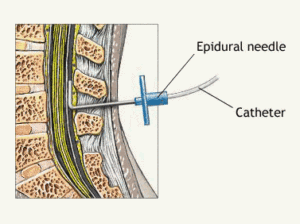Epidural Steroid Injection (ESI) is a common type of injection that is given to provide relief from certain types of low back and neck pain. The “epidural space” is the space between the covering of the spinal cord (dura mater) and the inside of the bony spinal canal. It runs the entire length of your spine. When injected into this area the steroid medication moves freely up and down the spine to coat the nerve roots and the outside lining of the facet joints near the area of injection. For example, if the injection is given in the lumbar spine, the medication will usually affect the entire lower portion of the spine.
The epidural needle is inserted into the back until the doctor feels sure it is in the epidural space. The doctor will then place a small amount of lidocaine into the epidural space and wait to see if you feel warmth and numbness in your legs. If so, the needle is most likely in the correct position. The remainder of the medication is injected and the needle is withdrawn.
Hospitals and anesthesiologists differ on the dosages and combinations of medication as well as on policies pertaining to moving around and eating/drinking after epidural placement. After epidurals muscle strength, balance and reaction are reduced.
Epidurals and scoliosis can be a concern for some people, especially if their scoliosis is severe. Since the area where the epidural is typically injected is in the lower back, this may not affect someone with mild scoliosis in their upper back. However, if the scoliosis is in the lower back, it can be difficult to get enough space in between the vertebrae to safely insert the needle.
Epidurals can be a concern for those who have undergone scoliosis surgery as well. With someone who has had scoliosis spinal fusion surgery it can be difficult to place the epidural and if it is placed it has to be lower than a usual epidural with can result in headaches.
If you have scoliosis it is important to discuss your options, and possible complications that may result, with your hospital’s anesthesiology department. They will determine whether it will even be an issue.
You may need to meet with the anesthesiologist to get evaluated ahead of time. As with all concerns, it is best to discuss them with your doctor and see what is best for you.
There are three different ways to perform an epidural injection: caudal block, translumbar, and transforaminal.
Caudal Block: placed through the sacral gap or the space below the lumbar spine near the sacrum (a shield-shaped bony structure that is located at the base of the lumbar vertebrae). The injection is placed into the epidural space. This type of block usually affects the spinal nerves at the end of the spinal canal near the sacrum. This collection of nerves is called the cauda equina. One of the benefits of this type of injection is less chance of puncturing the dura (the outermost membrane surrounding the spinal cord).
Translumbar: the most common way of performing an epidural injection. It is performed by placing a needle between two vertebrae from the back. The needle is inserted between the spinous processes ( long rearward projections from the arch of a vertebra that provide a point of attachment for muscles and ligaments) of two vertebrae. You can feel the spinous process by feeling the bumps along the back of your spine.
Transforaminal: a very selective injection around a specific nerve root. This type of epidural injection is used most often for diagnostic purposes, and is commonly administered in the neck. The foraminae are small openings between your vertebrae through which the nerve roots exit the spinal canal and enter the body. A specific nerve root can be isolated as the source of the problem by injecting medication around it.
Epidural anesthesia is the most popular method of pain relief during labor with more than 50% of women giving birth at hospitals using epidural anesthesia.
There are 2 basic epidurals in used during labor:
• Regular Epidural: After the catheter is in place, a combination of narcotic and anesthesia is administered either by a pump or by periodic injections into the epidural space.
• Combined Spinal-Epidural (CSE) or “Walking Epidural”: An initial dose of narcotic, anesthetic or a combination of the two, is injected beneath the outermost membrane covering the spinal cord, and inward of the epidural space. The anesthesiologist will pull the needle back into the epidural space, threading a catheter through the needle, then withdrawing the needle and leaving the catheter in place. This allows more freedom to move while in the bed and greater ability to change positions with assistance. With the catheter in place you can request an epidural at any time if the initial intrathecal injection is inadequate. CSE should provide pain relief for 4-8 hours.
Sources:
American Pregnancy Association
For more general information on pregnancy and epidurals:
